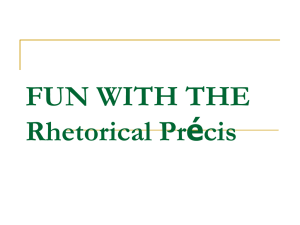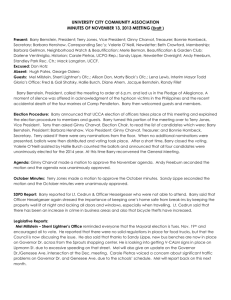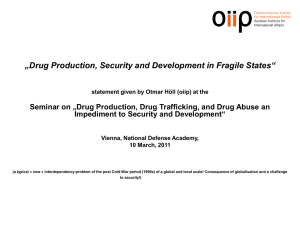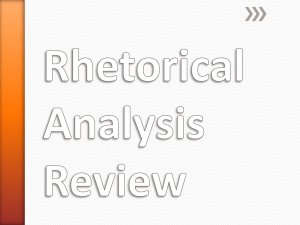PPT - Florida Institute of Technology
advertisement
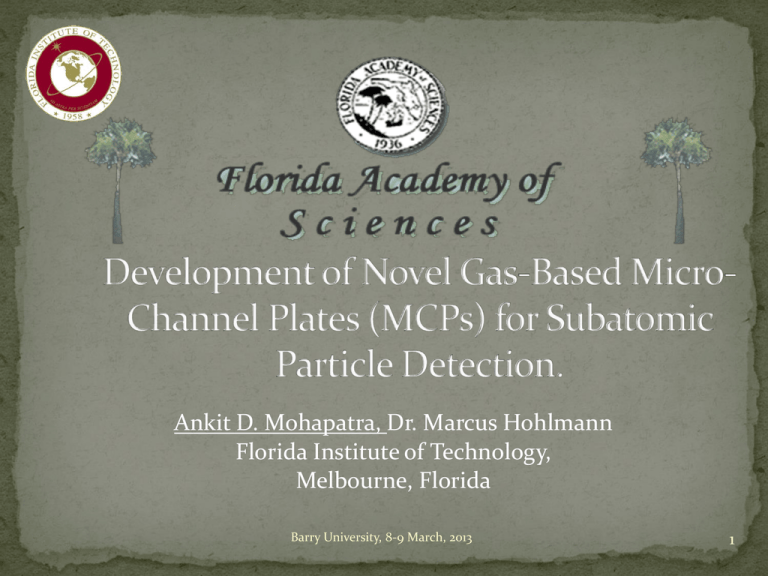
Ankit D. Mohapatra, Dr. Marcus Hohlmann Florida Institute of Technology, Melbourne, Florida Barry University, 8-9 March, 2013 1 Made from a borosilicate glass functionalized with a resistive and a secondary emissive coating both applied by atomic layer deposition (layer of metal oxide) … Kind of a hybrid detector where gain comes from two mechanisms : Metal oxide layer Gas gain The biggest assets of these detectors is their robust performance in magnetic fields. (Va’vra 2003 IEEE Nuclear Science Symposium) Barry University, 8-9 March, 2013 2 They have been there since 1985. (Probably the first paper) The earliest MCPs were used as pre-amplifiers to the Multi Wire Proportional Chambers (MWPCs) or as a standalone proportional counter. Barry University, 8-9 March, 2013 3 The first successful operation of MCPs (both single and double) as standalone detectors used along with photo-cathodes was shown by V. Peskov. * Gas gains as high as 104 (single MCPs) were observed . Most of the testing done on GCPs (Glass capillary tubes), which are MCPs not treated with H2. Significant charging up *(NIM A 433 (1999) 492-501) Barry University, 8-9 March, 2013 4 Gas-based MCPs with emissive coating have never been tested. Also the use of MCPs as a standalone detector for measuring the position of the extracted electron clouds (an approach similar to GEMs) has not been properly investigated. No prior knowledge of a gas mixture which could work for metal oxide coated gaseous MCPs(Magboltz simulation tells us it has to be a helium based mixture, still undecided about the quencher …) Barry University, 8-9 March, 2013 5 Just the dielectric, simulating half a hole … Post-processed MCP (potential map from cathode to anode) Barry University, 8-9 March, 2013 6 Only gas mixture where the probability of electrons having an energy more than 80 eV is non-negligible Barry University, 8-9 March, 2013 7 (T.Tamamura et al) Simulated Barry University, 8-9 March, 2013 8 X-Z view X-Y view Barry University, 8-9 March, 2013 9 Motion of electrons and ions in GEMs/MCPs (Sven Dildick) *To be replaced with animation from Garfield++ Barry University, 8-9 March, 2013 10 First we try to match the simulated gain with the experimental gain in GCPs from Peskov’s paper. The parameters are : Pitch : 130 microns Pitch Diameter : 100 microns Thickness : 800 microns Drift field : 720 Volts/cm* Drift space : 1 mm The gas mixtures used is Argon(95)/Methane(5) Barry University, 8-9 March, 2013 11 The main parameter to be fine-tuned in the simulation is the penning transfer ratio. Studied extensively in 2008 for Argon based mixtures (O.Sahin-JINST 2008) Penning transfer – group of processes by which excitation energy is used to increase the gas gain Literature suggests that the ratio should be ~20 % for Argon(95)/CH4. However we find it to be in the range 30-40. (Preliminary simulations have ruled out ratio greater than 50%), but we have not scaled the gain yet … (preliminary, it is a statistics game) Barry University, 8-9 March, 2013 12 Interestingly, the simulated gain would match with the measured gain if rp lies between 30 and 40 One can see that with increase in transfer ratio from o to 50, the gain increases exponentially Barry University, 8-9 March, 2013 13 The higher potentials have lesser statistics (the batch jobs are still running …) From preliminary simulation, rp should be between 30 and 40 (not in agreement with theory) (from Garfield++) Barry University, 8-9 March, 2013 Gain From Tamamura/Peskov’s paper 14 We can see that the gas mixture is not suitable for our purpose. (the mean energy is ~ 5 eV). The loss to attachment is very less (as expected ). Electron energy in eV Electron energy in eV Barry University, 8-9 March, 2013 15 A plot of the z-coordinates gives us an idea of how the geometric loss compares with the effective gain. Includes Geometric loss as well as the gain in Peskov’s scenario Effective gain when we want to extract the electron cloud Z-coordinate in microns Barry University, 8-9 March, 2013 16 A cleaner look at the geometric losses (plotting the electron end-points): One can see the holes clearly The cylindrical structure can beBarry seen University, 8-9 March, 2013 17 Collect more statistics to pin-point the penning transfer ratio for argon as well as helium based mixtures. (already have an estimate for He(90)/CO2(10) at ~34.5 % (from O.Sahin …) ) After that, predict the gain for the MCPs we have in the lab (1200 microns metal oxide coated) Compare it with the hardware results. Barry University, 8-9 March, 2013 18 Thanks …. Barry University, 8-9 March, 2013 19


